Kakadu & Top End
Taking a tumble or two in Kakadu
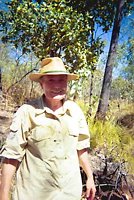
Rogene from Colorado wrote this report of a Willis's Walkabouts tour in Kakadu for friends, and has kindly given permission for it to be reprinted here. The trip was the Kakadu Super Circle #2 in June 2001
Kakadu is owned by Aboriginal people, leased to the federal gov. and jointly managed. This is an unusual arrangement which has resulted in some different policies. There is a desire to limit numbers of people, and preserve many sacred places, so there are few roads and all trail head type designations as well as special environmental spots are only accessible by 4 wheel drive. There are no trails throughout the park which is about the same size as Yellowstone, except for unimproved foot paths around highlighted falls etc. There is only one agency licensed to lead groups on foot which is Willis Walkabouts that we went on. Individuals can apply for a permit and sometimes be cleared to travel on foot. There are certain routes meaning corridors that guides are permitted to travel through in a certain amount of time. And so we began our journey at the end of a 6 hour drive from Darwin the last 30 or so kilometers on 4 wheel track. It was beside the Koolpin creek which had been cleared of salt water crocs, but they had a permanent croc trap there with a dead chicken or something in it to attract newcomers! Beautiful swim at your own risk.
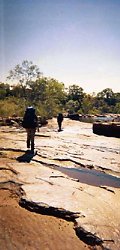
Our packs were heavy, not the heaviest I have carried, but our own gear plus food for 10 days. The next day we started out climbing up and around three sets of waterfalls. Beautiful country, but strenuous work as we were bouldering over rocks across water and scrambling up steep slopes in very high heat. I in particular felt the heat stress. Everytime we stooped our guide Andy would pour water on my head to help revive me! My feet were also bothering me so all in all a very stressful start. Kathleen did very well with her fear of heights. As she would climb around high rocks she just stayed focused and made it. Most of our camp sites were beside water, falls or cascades, and swimming was a refreshing relief from the heat. It took us about 4 days to get acclimatised to the heat and humidity.
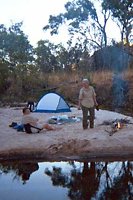
The next several days were spent trying to keep up with Andy our guide and Rodney the only other client on the trip. Those days were spent pushing ourway through high sword [spear] grass which had died and like all the other grasses gone to seed. The sword grass was waist to shoulder height so it was challenging. We had anticipated snakes, spiders, reptiles etc, but our biggest adversary was the green ant!! They build nest usually waist to head high in the grass by binding leaves together with a kind of silk to form a large cocoon at least as big as two of our fists. The men usually were in front and would disturb them and by the time Kathleen and I arrived they were ready to defend their territory and we were the target of their vengeance. We learned quickly to identify danger areas, but didn't always succeed before we would have an ant attack. Off would go the pack, a frantic look for those already biting and flicking off those headed for skin! They sure could bite. Rod had a skin reaction to them and occasionally Kathleen or I would have faint hives from unknown source probably ants. We learned from the Aboriginals that crushing the ants produces a very pungent sinus cleaning smell. They also eat them, their abdomens taste like lemon/lime so there you have it. When they build a new nest, they choose a spot and leaves they want to bind, hurry back to the old next, carry back the larvae which they squeeze to produce the silk to bind the edges of the leaves together. Quite a system, but I digress!! As we would walk along, we were great harvesters. The dead stalks would gather around our lower legs in large stacks which we would periodically shake off and leave behind for the person behind to dodge. Seeds gathered everywhere, particularly on my pants. I wore gaiters, but they would slip down and not provide much protection, so everytime we would stop for something I would spend most of my time picking off seeds, whether they fell on fertile ground was of no concern of mine.
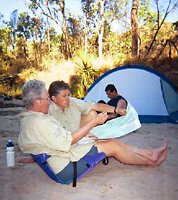
Andy was a good navigator, using map and compass well, he combined that with low impact traveling. That meant that he would weave around spider webs, termite mounds, new small plants, anything that would be destroyed by our feet and so we moved in a serpentine path through the land. As we learned, bushwalking here means walk rapidly between campsites so you can relax and spend your time at those lovely places [this is only the case for those trips in which distances necessitate this sort of walking - WW]. However we had in mind getting to know the area on the way and wanted to go much slower to see the birds, listen to the sounds, perhaps spot mammals, so this caused a bit of a conflict.
Besides high grasses, we traveled through burned over areas. In keeping with the old ways, everything is burned on a rotation cycle. It does make walking much easier, but also dustier with more ash floating around in the air. One day we could not find any suitable area to camp so camped amidst the ashes, not happy campers that night. There were also wetlands which we loved, full of sounds, easy walking as the grasses were short although wet under foot, birds, and we really dragged our feet there. Andy and Rod kept having to wait for us. There were several open woodland areas. In one I spotted the nest of the wedge tailed eagle. As we got closer, the eagle was on the nest. What a sight. They are very large birds. Also red tailed black cockatoos. Once we walked for several hours in an area that looked like the Serengeti and kept looking around expecting to see large animals. The only large animals there were introduced species--pig and water buffalo--both a nuisance now. Saw pigs occasionally but never the buffalo. Both make large wallows and narrow trails. When the trails went our way we would follow them and walking would be easy, but generally they weren't following our compass bearing!
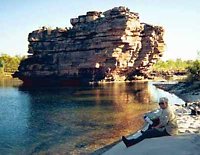
We did see a small fresh water croc. They are harmless unless provoked and then they couldn't eat you. So people swim when they are around, even consider it safe because if there was a salt water croc, it would eat the freshie. Kathleen spotted a northern quoll and several wallaroos. But that was the extent of our mammal spotting. Most animals here are nocturnal. Lots of birds that we heard and couldn't identify, and many which we were able to check off.
So what was our response overall? The days were a struggle, and the campsites were delightful. Andy was knowledgeable about Aboriginal rock art so we got to see lots of those along the way which was a good experience. We wanted to see Kakadu up close and personal and that happened--sometimes too upclose. All of us took a tumble at some point when our toe snagged a root or rock and a rock side stepped on us. It was incredible to find a place where you drank the water out of the creeks without treating it and where we saw no trace of another person for 9+ days, not a foot print in the sand or bit of trash anywhere. There was a sense of how harsh life could be in the bush and why the ancient ways included fire to make traveling easier and hunting more successful. It is an old land, leveled off with large rock piles wearing down over time. Images left from 10,000 or more years ago tied you into a culture really unknown yet perhaps understandable. The starry skies were the clearest I have ever seen. The southern cross, magellenic clouds, nebulas, milky way brilliant. No pollution stood in our way of gazing up for hours in the evening and when you awoke during the night. The sounds of the wetlands were loud and almost symphonic while there was a stillness and death like hush in the burned over areas. At the time the difficulty of bushwalking almost overshadowed the uniqueness of the experience. The variety of plants to become acquainted with was mind boggling. We learned quickly to identify spinifex grass which had sharp ends and a irritating substance that our skins reacted to and pandanus which had long frond leaves with spikes like a black berry bush that would catch as we went by.
The further away from the bush we get and experience the quick overviews at other places, the more I appreciate the bush walk. Other people only experience the tours that take you in to one place, 30 mins, or so and then back out. We lived for 10 days in, on the land. It was not always fun or easy, but we did see Kakadu as most others don't and that will remain with us in a much deeper sense than just the picture taking opportunities offered by others. Only about 20 groups get to go into Kakadu with Willis Walkabouts during the year over many different routes, so it could only be classified as special.
Rogene
 share
share